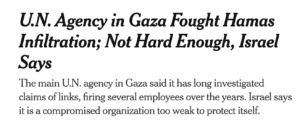Within hours of the IDF revealing the extensive tunnel beneath UNRWA’s headquarters in the Gaza Strip, the UN agency’s Commissioner-General Philippe Lazzarini was on the defensive.
“UNRWA did not know what is under its headquarters in Gaza,” he claimed on the social media site X (formerly Twitter), prompting a fair amount of ridicule given UNRWA’s long history of seeing its facilities used by Hamas to hide terrorist infrastructure.
Lazzarini added 10 more equally unconvincing points underneath, including an assurance that no UNRWA staff were “aware of any activity that may have taken place there.”
Strange that nobody who worked at UNRWA’s Gaza HQ noticed the cables that diverted electricity directly from UNRWA’s supply and right into Hamas’ control room below.
Likewise, they must have missed all of the other blindingly obvious clues as to who was sharing their basement, like terrorists filing in and out of the headquarters daily and computers and steel doors being delivered to the facility.
Indeed, as one journalist observed, it took a total of “two minutes touring UNRWA’s headquarters in the heart of the upscale Rimal neighborhood to understand that they knew everything.”
– UNRWA did not know what is under its headquarters in Gaza.
– UNRWA is made aware of reports through the media regarding a tunnel under the UNRWA Headquarters in Gaza.
– UNRWA staff left its headquarters in Gaza City on 12 October following the Israeli evacuation orders and as…
— Philippe Lazzarini (@UNLazzarini) February 10, 2024
Yet, when evidence was released by the IDF of the Hamas command center being quite literally beneath UNRWA’s nose, it was met with what could only be described as sheer incredulity at The New York Times while some other media treated this dramatic discovery with barely an acknowledgment.
Rather than report on the IDF’s disturbing findings, particularly how it is likely UNRWA staff knew of the terror base, the NYT reframed the story to push a wildly distorted narrative of a plucky UNRWA fighting against Hamas in the Strip and resisting the terror group’s efforts to infiltrate the UN agency:

Worryingly, the piece only mentions the uncovering of the tunnels beneath UNRWA’s offices in the 17th paragraph of the piece, with the article’s authors Patrick Kingsley and Ronen Bergman suggesting the IDF only showed journalists this particular tunnel network to “bolster [Israel’s] argument” that UNRWA “has done too little to stop Hamas from building military infrastructure close to its facilities.”
Most of the story is instead dedicated to an implicit defense of UNWRA, including anonymous former staffers’ assurances that the agency has “long taken seriously and investigated accusations of infiltration by Hamas” and the NYT casting doubt on whether UNRWA staff would have spotted the tunnels.
What’s more, at least one journalist from the paper, along with various other domestic and foreign media, was physically taken on a tour of the tunnel by the IDF, which should have left no doubt as to the magnitude of the story.
Sadly, The New York Times wasn’t alone in its effort to recast UNRWA as an innocent victim in this whole saga.
The Associated Press appeared to suggest Israel had only “unveiled” the tunnels as a way of attacking UNRWA in a piece that stated: “The unveiling of the tunnels marked the latest chapter in Israel’s campaign against the embattled agency, which it accuses of collaborating with Hamas.”

CNN, meanwhile, relegated the story to a short post included in its live updates feed. Casting doubt on the existence of the tunnels at all, CNN turned the story into mere “claims” made by Israel against the UN agency, describing the tunnel as an “alleged finding.”
It couched the finding as occurring against a backdrop in which “Israel has longstanding issues with UNRWA,” suggesting the evidence is part of some nefarious campaign against an organization tasked with caring for Palestinians.
Judging from the lack of a dedicated story, it appears nobody from CNN was represented on the IDF’s press tour of the UNRWA tunnel. But the simple fact that multiple journalists from other top-tier publications were able to verify the findings for themselves makes one wonder why CNN didn’t see the stories from those media that had been on the tour.
At least that’s what The Washington Post did when it stated: “The military showed journalists from the Associated Press and other outlets what it said was an electrical supply hub powering tunnel infrastructure in the area.”
Sadly, the tunnel story was buried 12 paragraphs in at the end of The Post’s war coverage and framed as Israel having “taken aim” at UNRWA.
In summary, the international media were presented with further damning evidence of UNRWA’s infiltration by Hamas terrorists in the form of its HQ directly above a Hamas base.
So why did they have such trouble believing the evidence or treating it in a way that isn’t portrayed as an Israeli assault on UNRWA?
Liked this article? Follow HonestReporting on Twitter, Facebook, Instagram and TikTok to see even more posts and videos debunking news bias and smears, as well as other content explaining what’s really going on in Israel and the region.
Photo credit: JACK GUEZ/AFP via Getty Images



